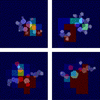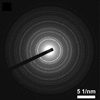issue contents
March 2024 issue

editorial
BIOLOGY | MEDICINE
Researchers have long sought to `see' proteins and other macromolecules in motion, to better understand their functions. Technological developments, notably advances in serial crystallography, are now making these dreams a reality, heralding a new era of kinetic crystallography.
scientific commentaries
NEUTRON | SYNCHROTRON
Small-angle X-ray scattering has revealed how magnetic Janus particles pair up in solutions in small and large magnetic fields.
research letters
BIOLOGY | MEDICINE
A structure is presented for vancomycin bound to the resistance-associated epitope D-Ala-D-Ser. This high-resolution view of the complex suggests that the reduced affinity of vancomycin for this epitope stems from a subtle size mismatch between the ligand and the antibiotic, in addition to potential unfavorable entropic effects.
PDB reference: 8g82, vancomycin bound to D-Ala-D-Ser
research papers
CRYO | EM
This white paper describes recommendations to the wwPDB, EMDB and the cryoEM communities regarding archiving and validation of single-particle structures and volumes.
BIOLOGY | MEDICINE
We propose a direct-methods-based dual-space iteration strategy for model completion of molecular replacement (MR) with predicted models. Direct methods has been demonstrated as a powerful tool for phase optimization in protein crystallography, whereas the dual-space iterative strategy is particularly suitable for solving crystallographic protein-complex structures starting from a small subunit. This combined approach provides a shortcut in simplifying the pre-processing steps of predicted models for MR and for final model completion.
CHEMISTRY | CRYSTENG
Download citation


Download citation


Pressure was successfully used to induce single and double proton-transfer reactions in malonic acid and the 4,4′-bipyridine cocrystal. After contrasting with similar literature examples, an extended correlation between the ΔpKa values of coformers and the pressure necessary to initiate proton-transfer reactions is unveiled.
CHEMISTRY | CRYSTENG
This work involves extraction of salen metal complexes from the Cambridge Structural Database for deep learning to examine the 3D structural features that allow such complexes to act as single-molecule magnets. This research attempts to link a crystal structure database as big data with the molecular design of nanomaterials using artificial intelligence. The approach pioneers the future secondary use of similar crystal structure data.
PHYSICS | FELS
Various approaches for lossless and lossy compression are evaluated, and suitable quality assessment metrics for serial crystallographic data – used in combination with lossy data reduction – are described.
ELECTRON CRYSTALLOGRAPHY
A new method is proposed to enhance the continuity of diffraction rings and improve the signal-to-noise ratio in electron diffraction data for electron pair distribution function (ePDF) analysis.
MATERIALS | COMPUTATION
The 3N-dimensional maxima of the square of the wavefunction, the so-called Born maxima, show beyond doubt that the electronic structure of atoms persists in molecules, either in their original ground state or some low-lying excited state. The electron density is only a low-dimensional projection of this much richer landscape.
CHEMISTRY | CRYSTENG
Download citation


Download citation


This study demonstrates the synthesis of non-cytotoxic active candidates (co-crystals) of coumarin-3-carboxylic acid with various coformers to target the MIL-resistant Leishmania tropica. These promising anti-leishmanial results indicate the importance of crystal engineering by highlighting that manipulation of supramolecular architecture in the solid state can impact the biological response.
BIOLOGY | MEDICINE
Download citation


Download citation


Microfluidic manipulation of droplet volume coupled with seeding can be used to precisely control crystal size. Droplet microfluidics also enables fast, millisecond-scale micromixing for advancing time-resolved serial crystallography.
PDB references: lysozyme control, 8s2u; lysozyme droplet, 8s2v; Pdx1 control, 8s2w; Pdx1 droplet, 8s2x
CHEMISTRY | CRYSTENG
A databank of atomic densities calculated using Hirshfeld partition has been developed which allows for refinement with similar accuracy to Hirshfeld atom refinement without the need for time-consuming wavefunction calculations.
BIOLOGY | MEDICINE
The structures of novel redox domains extracted from two large extracellular redox proteins encoded in the genome of Teredinibacter turnerae suggest potentially novel roles for electron-transfer proteins in carbohydrate chemistry outside of the cell.
PDB references: TtX122B, a domain of unknown function from the Teredinibacter turnerae protein TERTU_2913, 8q2a; TtX183B , a c-type cytochrome domain from the T. turnerae protein TERTU_2913, 8q1w; Se-Met labelled TtX122A, a domain of unknown function from the T. turnerae protein TERTU_3803, 8q28; TtX183A, a c-type cytochrome domain from the T. turnerae protein TERTU_2913, 8q1v; TtX122A, a domain of unknown function from the T. turnerae protein TERTU_3803, 8q29


 journal menu
journal menu




 access
access



























